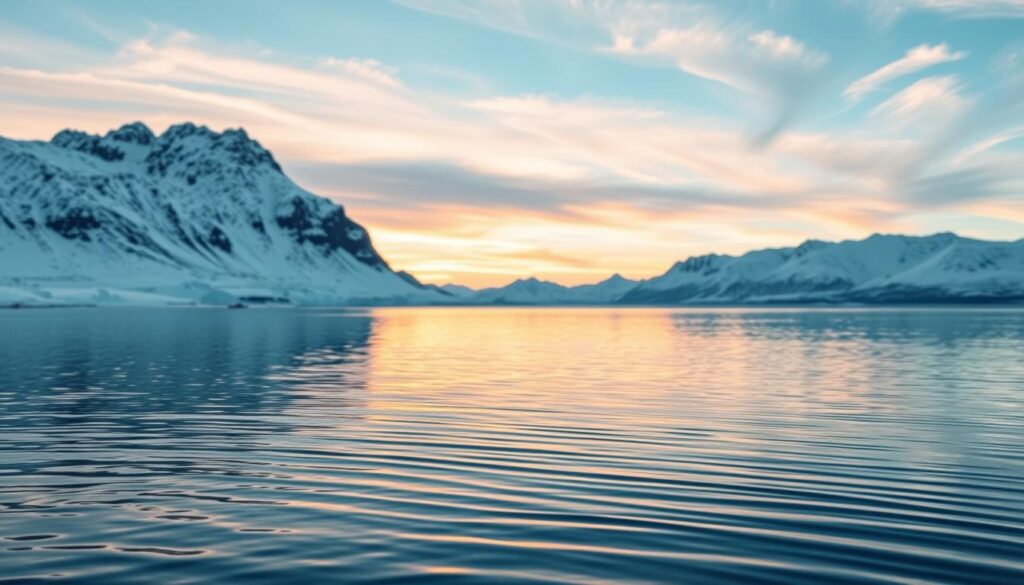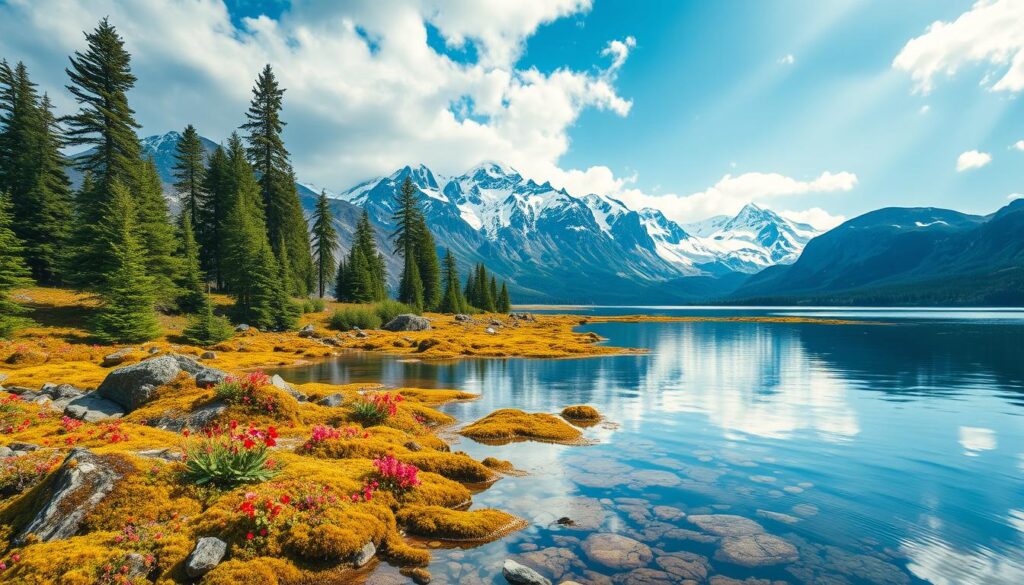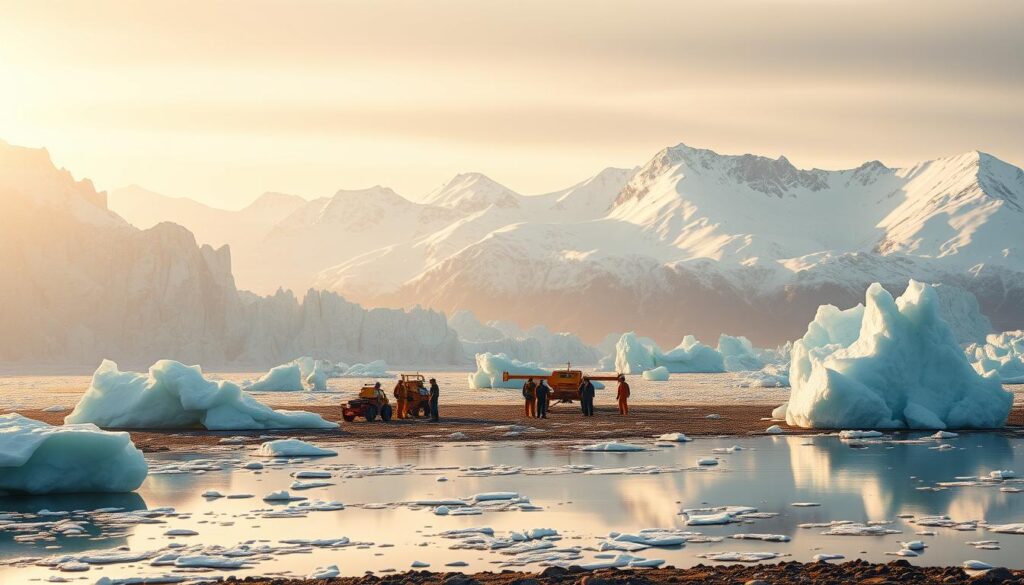The Arctic is known for its cold climate. But, there’s a special lake that stays warm all year. This has caught the attention of scientists and adventurers. We’ll look into the secrets of this warm lake, a true marvel.

This wonder has sparked a lot of curiosity. We’ll find out where it is, its geography, and how it stays warm. It’s a remarkable lake, even in the cold Arctic.
Key Takeaways
- Discover the unique Arctic lake that stays warm year-round
- Learn about the natural heating mechanisms behind this phenomenon
- Explore the location and geography of this natural wonder
- Understand the significance of this Arctic lake in the scientific community
- Get an overview of the fascinating world of this warm lake, a true natural wonder
The Mysterious Lake that Stays Warm in the Arctic
The warm lake in the Arctic is a fascinating topic. It has caught the attention of many scientists and researchers. To grasp this wonder, we need to explore its location, geography, and how it was discovered.
This lake is found in a remote Arctic area. It’s surrounded by ice and snow. Yet, it stays warm all year round.
Several factors make this lake special:
- Geothermal activity: The lake’s close location to geothermal hotspots helps keep it warm.
- Insulating properties: The ice and snow around it trap heat, keeping the lake warm.
- Underwater springs: These springs might also help keep the lake’s temperature steady.
Studying this warm lake helps us understand the Arctic better. It shows us how the lake stays warm. This knowledge is key to understanding the Arctic ecosystem.
Natural Heating Mechanisms Behind the Warmth
The Arctic lake’s unique ecosystem is supported by natural heating. Scientists have several theories, like geothermal activity, solar radiation, and microorganisms. These need more study to fully understand the lake’s warmth.
Some key factors include:
- Geothermal activity, which provides heat from the Earth’s interior
- Solar radiation, which warms the lake’s surface
- Microorganisms, which play a crucial role in the lake’s ecosystem
More research is needed to understand the lake’s warmth. This could reveal new insights into our planet. It shows the importance of scientific research.
Studying the Arctic lake’s heating can deepen our understanding of its ecosystem. This knowledge helps in conservation and protecting the lake. It highlights the role of research in preserving our planet.
Unique Ecosystem and Wildlife
The warm water lake is home to a wide variety of life. This includes fish and microbial life, making it a unique place to study. The lake’s warm waters support fish species found only in the Arctic.
Surrounding the lake, plants thrive in the warm climate. These plants are key to the lake’s ecosystem. They provide food and shelter for the lake’s inhabitants. The microbial life in the lake also holds secrets about life’s evolution.
- Adaptation to warm waters: The lake’s unique ecosystem is adapted to the warm waters, making it an ideal location for studying the effects of climate change.
- Diverse range of life: The lake is home to a diverse range of life, from fish species to microbial life, creating a complex and fascinating ecosystem.
- Importance of flora: The flora surrounding the lake plays a crucial role in the lake ecosystem, providing food and shelter for the various species that inhabit the lake.
Studying the warm water lake’s ecosystem is vital. It helps us understand the complex relationships between its species. More research is needed to fully grasp the lake’s ecosystem and its secrets about life’s evolution.
Year-round Temperature Patterns
Scientists are keen on studying the Arctic lake’s temperature patterns for Arctic research. The lake stays relatively the same temperature all year, even when it’s freezing outside. This makes it perfect for scientific studies, and we need to protect it from human harm.
Several factors help keep the lake’s temperature steady. These include:
- Geothermal activity
- Insulation from the surrounding environment
- Unique water circulation patterns
The lake’s constant temperature supports a wide variety of plants and animals. This makes it crucial for conservation efforts. By studying the lake, scientists can learn more about our planet’s natural processes. This knowledge helps with Arctic research and other important projects.
Visiting the Arctic Warm Lake
Planning a trip to the Arctic warm lake is an exciting adventure. It requires careful consideration of the unique environment and ecosystem preservation. The Arctic lake is a fragile and sensitive ecosystem that supports a wide range of plant and animal life. To ensure a safe and enjoyable visit, it’s essential to choose the right time and mode of transportation.
The best time to visit the Arctic lake is during the summer months. The weather is warmer, and the days are longer. This period offers the best opportunity to experience the lake’s natural beauty and observe the local wildlife.
Best Times to Visit
- Summer solstice: The longest day of the year offers the most daylight hours to explore the lake and its surroundings.
- Autumn: The fall season brings a kaleidoscope of colors to the surrounding landscape, making it a great time for photography and nature walks.
Transportation Options
There are several transportation options available to reach the Arctic warm lake, including flights and boat tours. It’s crucial to choose a mode of transportation that minimizes the impact on the ecosystem preservation and respects the Arctic lake’s fragile environment.
Activities and Experiences at the Lake
The Arctic warm lake is a special place for many activities and experiences. Visitors can join guided tours or help with scientific research. They can also explore the area, learn about its history, and take part in experiments.
Adventure lovers can hike, fish, or kayak here. These activities let you dive into the unique ecosystem and see amazing views. The lake is also great for fishing because of its warm waters and many fish species. The plants and microbes around the lake are interesting for those interested in scientific research.
Some activities and experiences at the lake include:
- Guided tours of the lake and its surroundings
- Participation in scientific experiments and research projects
- Hiking and kayaking trips to explore the lake’s scenery and wildlife
- Fishing and angling opportunities in the lake’s warm waters

By trying these activities, visitors can really appreciate the Arctic warm lake’s unique ecosystem. They also learn about the value of scientific research in keeping this natural wonder safe. Whether you’re into adventure, science, or just want to see beautiful views, the Arctic warm lake has something for you.
Scientific Research and Discoveries
The Arctic warm lake is a key area for Arctic research. Scientists from all over the world are studying it. They want to learn about its unique features and how it fits into our planet’s ecosystem.
Researchers are looking into how the lake’s temperature works and how climate change affects it. They also hope to find new species and create new tech for conservation efforts. Some main research areas include:
- Hydrothermal activity and its effects on the lake’s temperature
- The impact of climate change on the lake’s ecosystem and biodiversity
- The development of new technologies to support conservation efforts
There’s a lot more to discover in this lake. Scientists can learn a lot about our planet by studying it. By supporting Arctic research and conservation efforts, we can protect this amazing place for the future.
| Research Area | Description |
|---|---|
| Thermal Dynamics | Study of the lake’s natural heating mechanisms and thermal dynamics |
| Climate Change | Research on the impact of climate change on the lake’s ecosystem and biodiversity |
| Conservation | Development of new technologies and strategies to support conservation efforts |
Environmental Conservation Efforts
The Arctic warm lake is a delicate ecosystem that needs our protection. Environmental conservation is key to keeping it safe. We aim to make sure research is done in a way that doesn’t harm the lake.
Protecting the lake involves setting up protected areas and controlling human activities. We also keep an eye on how climate change affects it. These steps help keep the ecosystem balanced and safe for its inhabitants.

Here are some important strategies for ecosystem preservation:
- Reducing human impact through sustainable tourism practices
- Implementing effective waste management systems
- Supporting research and monitoring programs to track climate change impacts
Protecting the Arctic warm lake is a team effort. It requires the work of researchers, policymakers, and the public. Together, we can keep its ecosystem thriving for future generations. This means we all need to focus on environmental conservation and ecosystem preservation.
Photography and Observation Points
The Arctic lake is a paradise for photographers and nature lovers. It has a unique ecosystem with many plant and animal species. The lake’s beauty, surrounded by stunning landscapes, makes it perfect for photography and observation.
There are many spots around the lake for photography and observation. You can find hiking trails, viewing platforms, and guided tours. Visitors can take amazing photos of the lake and its surroundings. They can also see the unique plants and animals that live there.
- Hiking and trekking
- Wildlife watching and photography
- Kayaking and fishing
The Arctic lake’s unique ecosystem attracts tourists and scientists. It offers a chance to see and study the area’s diverse plants and animals. Whether you’re a professional photographer or just love nature, the Arctic lake is a must-see. It will leave you amazed by its natural beauty and unique ecosystem.
Safety Guidelines and Preparations
Visiting the Arctic warm lake needs careful planning. The weather and environment can be harsh. It’s important to prioritize safety and responsible travel. Before you go, consider these essential guidelines for a safe and fun trip.
Packing the right gear is key. You’ll need warm clothes, waterproof stuff, and a first aid kit. The cold, wind, and snow can be tough. So, being prepared is crucial.
- Bring essential gear, such as warm clothing and a first aid kit
- Be aware of weather considerations, including extreme cold, wind, and snow
- Have a plan in place in case of an emergency, including a communication plan and evacuation plan
By focusing on safety and responsible travel, you help protect the Arctic. Stay informed about the latest Arctic research and guidelines. This way, you’ll have a safe and enjoyable visit.
Conclusion
Our journey through the Arctic lake shows it’s a true marvel. Despite the cold, it’s a place of wonder and beauty. Its unique heating and lively ecosystem have amazed many.
We must respect and care for this special place. By protecting it and promoting eco-friendly tourism, we can keep it amazing for future visitors. This way, it will continue to inspire and amaze people.
If you love nature, adventure, or just the beauty of our world, you’ll love the Arctic warm lake. It’s a place that will stay with you forever. So, get ready, dress warmly, and explore this incredible natural wonder in the Arctic.
FAQ
What is the Arctic warm lake?
The Arctic warm lake is a natural wonder in the Arctic’s remote areas. It stays warm all year, even in the Arctic’s cold climate. This has fascinated scientists and adventurers.
Where is the Arctic warm lake located?
It’s in a remote Arctic area, surrounded by ice and snow. Its exact location is kept secret to protect the ecosystem.
What are the natural heating mechanisms behind the lake’s warmth?
The lake’s warmth is due to complex natural processes. Geothermal activity, solar radiation, and unique microorganisms are thought to play a role. More research is needed to understand it fully.
What kind of unique ecosystem and wildlife can be found in the Arctic warm lake?
The lake has a unique ecosystem. It’s home to special fish and a variety of plants and microbes. This makes it fascinating for scientists and nature lovers.
What are the year-round temperature patterns of the Arctic warm lake?
The lake’s temperature stays constant all year. This is unusual given the cold around it. It’s perfect for scientific studies.
What are the best times to visit the Arctic warm lake?
Summer is the best time to visit. The weather is warmer and the days are longer. You can fly or take a boat tour. There are many places to stay, from campsites to luxury lodges.
What activities and experiences are available at the Arctic warm lake?
There’s a lot to do here. You can go on guided tours, conduct scientific experiments, hike, fish, and kayak. It’s a chance to see the unique ecosystem and learn about ongoing research.
What kind of scientific research is being conducted at the Arctic warm lake?
Scientists are studying how the lake stays warm. They’re also exploring the diverse ecosystem. The lake could reveal new insights into our planet.
What environmental conservation efforts are in place to protect the Arctic warm lake?
Protecting the lake is crucial. Efforts include creating protected areas and regulating human activity. Monitoring climate change impacts is also important.
What safety considerations should visitors keep in mind when visiting the Arctic warm lake?
Visiting the lake requires careful planning. Bring warm clothes and a first aid kit. Be aware of the weather, including extreme cold and wind. Have emergency plans ready.
